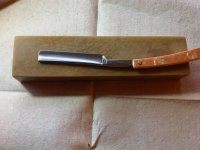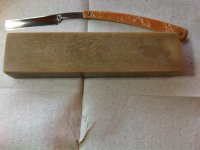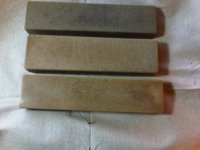I'm assuming this will take a while to repair. It's about 1/16" to 3/32 " deep in the middle of the blade. Will anything but bread knifing strokes damage the blade? Anything I should watch out for? Stone recommendations?
You are using an out of date browser. It may not display this or other websites correctly.
You should upgrade or use an alternative browser.
You should upgrade or use an alternative browser.
Best Practice for Removing a Chip in Blade?
- Thread starter duke762
- Start date
kelbro
Alfred Spatchcock
A pic would be great. If it's a hollow grind then I would do 45 degree spine off the stone until the chip is like 75% gone and then start again with the spine on the stone.
Yep, like that.
Slash McCoy
I freehand dog rockets
Not me. I would just hone it. If you take a lot of steel from the edge then IMHO you need to take a lot from the spine too. Just go at it til chip is gone. You can start out with very coarse media to do the heavy lifting. A 200 grit diamond plate from Harbor Freight can make a lot of steel go away pretty quick. Move up to something finer when the chip is nearly gone.
- Thread starter
- #5
Thank you Gentlemen! I used the 45 degree method to save on spine wear and it worked like a charm. Resetting bevel tonight.
Not me. I would just hone it. If you take a lot of steel from the edge then IMHO you need to take a lot from the spine too. Just go at it til chip is gone. You can start out with very coarse media to do the heavy lifting. A 200 grit diamond plate from Harbor Freight can make a lot of steel go away pretty quick. Move up to something finer when the chip is nearly gone.
Slash, what words would I use to find that diamond plate in the Harbor Freight web site?
Slash McCoy
I freehand dog rockets
Get some 320 SIC sand paper!
First I figure out where the geometry is at, and how much wiggle room I have to keep things where I like them. Taking notable dimsion off the width will impact the bevel's angle proportionately.
If I can avoid creating a stout bevel angle; that is a first consideration. Spine wear isn't a concern for me unless the blade is super special somehow.
I usually won't breadknife a blade, if I do, I will only go 1/3 - 1/2 way.
But usually, I just hone small chips out. I may opt to do part of the work with tape, and then finish off the bevel without tape. It all depends on the geometry; let's say it's one of those 5/8 Sheffie near-wedges and it's been loved alot. So the bevel angle is, already, like - 18˚. In that case, I'll do what I can to keep the angle where it is.. through experience, I know I definitely don't want to go for a wider bevel on that blade.
But if I have a 5/8 hollow grind, 4.5mm spine, 16mm of blade width; the angle is 16.2˚.
Let's say there is a 1/16" chip.
If I hone the blade with a taped spine, the resulting angle after the chip is gone will be 18˚.
I might be ok there, but I'd probably opt to do some (1/2) of the repair on tape but finish without tape; I'd be hoping for a 17˚ bevel.
Sixgun's 45˚ mock-breadknife routine adds nothing to the equation for me; it's the same as a 1/2 bread knife but more involved. But, you know - whatever's clever.
If I can avoid creating a stout bevel angle; that is a first consideration. Spine wear isn't a concern for me unless the blade is super special somehow.
I usually won't breadknife a blade, if I do, I will only go 1/3 - 1/2 way.
But usually, I just hone small chips out. I may opt to do part of the work with tape, and then finish off the bevel without tape. It all depends on the geometry; let's say it's one of those 5/8 Sheffie near-wedges and it's been loved alot. So the bevel angle is, already, like - 18˚. In that case, I'll do what I can to keep the angle where it is.. through experience, I know I definitely don't want to go for a wider bevel on that blade.
But if I have a 5/8 hollow grind, 4.5mm spine, 16mm of blade width; the angle is 16.2˚.
Let's say there is a 1/16" chip.
If I hone the blade with a taped spine, the resulting angle after the chip is gone will be 18˚.
I might be ok there, but I'd probably opt to do some (1/2) of the repair on tape but finish without tape; I'd be hoping for a 17˚ bevel.
Sixgun's 45˚ mock-breadknife routine adds nothing to the equation for me; it's the same as a 1/2 bread knife but more involved. But, you know - whatever's clever.
^^^^^^This.First I figure out where the geometry is at, and how much wiggle room I have to keep things where I like them. Taking notable dimsion off the width will impact the bevel's angle proportionately.
If I can avoid creating a stout bevel angle; that is a first consideration. Spine wear isn't a concern for me unless the blade is super special somehow.
I usually won't breadknife a blade, if I do, I will only go 1/3 - 1/2 way.
But usually, I just hone small chips out. I may opt to do part of the work with tape, and then finish off the bevel without tape. It all depends on the geometry; let's say it's one of those 5/8 Sheffie near-wedges and it's been loved alot. So the bevel angle is, already, like - 18˚. In that case, I'll do what I can to keep the angle where it is.. through experience, I know I definitely don't want to go for a wider bevel on that blade.
But if I have a 5/8 hollow grind, 4.5mm spine, 16mm of blade width; the angle is 16.2˚.
Let's say there is a 1/16" chip.
If I hone the blade with a taped spine, the resulting angle after the chip is gone will be 18˚.
I might be ok there, but I'd probably opt to do some (1/2) of the repair on tape but finish without tape; I'd be hoping for a 17˚ bevel.
Sixgun's 45˚ mock-breadknife routine adds nothing to the equation for me; it's the same as a 1/2 bread knife but more involved. But, you know - whatever's clever.
One other thing that needs mentioning is some of these chipped razors are not worth the time and effort. Does anyone think a 2 hour chip removal session is worth it for a +/- $20 blade? Lol. If you chip one up good just buy another one . But everyone decides whether their time is valuable or not.
An alternative view is that if I an only interested is saving time, I would use a cartridge razor. I find straight razor shaving takes way more time than Mach 3 for instance. Straight razor shaving is slower in my opinion, plus one must strop and hone. On straight shaver's opinion. I almost forgot, forum time is significant.. Jody.
I just picked up three razors for $20 last night, one was a red imp with a couple minor (i think) chips in the blade. This post MAY be getting reread a couple times  The other two were great condition, a Genco and a John Heiffor with a fish etched on the blade. Made in sheffield (no england), so may be pre-1891. I can't wait to get them all shave ready, so thanks for everyone's insight!
The other two were great condition, a Genco and a John Heiffor with a fish etched on the blade. Made in sheffield (no england), so may be pre-1891. I can't wait to get them all shave ready, so thanks for everyone's insight!
I have tried bread-knifing in the past and it worked well in the immediate sense, but then came a major amount of payback time to reset the bevel. Since then, and depending on the depth of the chip, I will use a fine DMT with or without a taped spine using up and down strokes, removing the tape, if used, in moving to a 1k synth. If the chip is deeper, then I will use a coarse DMT with a taped spine in the same way, followed by the fine DMT in the same way, again removing the tape in moving to the 1k. Since moving to the DMTs and honing without bread-knifing, the move to the 1k has been a very smooth transition. Also, the diamond hones should be fairly worn.
I forgot to mention above that I use 220x & 320x Shapton Pro stones for chip removal. Normally, a small chip doesn't require using the 220x though. Those stones are blazing fast.
As for start-to-finish speed - objectively, the 45˚ approach didn't speed up anytihng for me. I'm not saying it won't work, lots of things 'work' - I know it'll work because I've used that approach; it's been around for a while. In my side by side comparison, that method was not faster. Honestly, the concept seems like an ego-driven attempt to create a solution to a non-existent problem.
But, at the end of the day it doesn't matter how the job gets done, so long as it gets done.
And if I want to get the job done faster, I just use a coarser/faster stone.
As for start-to-finish speed - objectively, the 45˚ approach didn't speed up anytihng for me. I'm not saying it won't work, lots of things 'work' - I know it'll work because I've used that approach; it's been around for a while. In my side by side comparison, that method was not faster. Honestly, the concept seems like an ego-driven attempt to create a solution to a non-existent problem.
But, at the end of the day it doesn't matter how the job gets done, so long as it gets done.
And if I want to get the job done faster, I just use a coarser/faster stone.
- Thread starter
- #16
I was using diamond hones from Harbor Freight, worn a bit, but I felt I was getting more done mixing it up with both bread knife and 45's. Bevel set was a bear....started with India stones to just get a bit of a shape to it. I've gone too far with them in the past and gotten micro chipping as a reward. This is while just barely kissing the spine to the hone. Next up I used a brown, translucent Washita/Soft/Hard thingy. Neither of my 2 Pike #1's were interested in what I was doing. The brown thing was a bit run in so I added Coticule slurry to speed thing along. Love the feel! Used the burr method and quite a bit of torque to save the spine. 50 laps a side til the burr formed. Went to a Coticule and did the best I could, finished up on a vintage Norton Trans. Back in service! Pictures of the brown thingy and the razor after repair. Picture with 3 stones are a Pike #1, a soft Ark, and the brown thing.
Attachments
I bought this Henckels 9 to learn how to remove chips. My plan is to breadknife the razor using the method that gssixgun (Glen Mercurio) shows in this video using the 400 and/or 1000 grit sides of my cheapo diamond plate:
In the video, Glen uses a rolling stroke on a worn 325 DMT plate to breadknife the edge starting with a 60-degree angle.
Comments are welcome.

In the video, Glen uses a rolling stroke on a worn 325 DMT plate to breadknife the edge starting with a 60-degree angle.
Comments are welcome.
A pike no. 1 is what I use and it works like a dream. My favorite stone for chips.I was using diamond hones from Harbor Freight, worn a bit, but I felt I was getting more done mixing it up with both bread knife and 45's. Bevel set was a bear....started with India stones to just get a bit of a shape to it. I've gone too far with them in the past and gotten micro chipping as a reward. This is while just barely kissing the spine to the hone. Next up I used a brown, translucent Washita/Soft/Hard thingy. Neither of my 2 Pike #1's were interested in what I was doing. The brown thing was a bit run in so I added Coticule slurry to speed thing along. Love the feel! Used the burr method and quite a bit of torque to save the spine. 50 laps a side til the burr formed. Went to a Coticule and did the best I could, finished up on a vintage Norton Trans. Back in service! Pictures of the brown thingy and the razor after repair. Picture with 3 stones are a Pike #1, a soft Ark, and the brown thing.
On those old washitas the surface needs to be "refreshed" from time to time. A quick buff with anything between 220-400 and you'll be golden.I was using diamond hones from Harbor Freight, worn a bit, but I felt I was getting more done mixing it up with both bread knife and 45's. Bevel set was a bear....started with India stones to just get a bit of a shape to it. I've gone too far with them in the past and gotten micro chipping as a reward. This is while just barely kissing the spine to the hone. Next up I used a brown, translucent Washita/Soft/Hard thingy. Neither of my 2 Pike #1's were interested in what I was doing. The brown thing was a bit run in so I added Coticule slurry to speed thing along. Love the feel! Used the burr method and quite a bit of torque to save the spine. 50 laps a side til the burr formed. Went to a Coticule and did the best I could, finished up on a vintage Norton Trans. Back in service! Pictures of the brown thingy and the razor after repair. Picture with 3 stones are a Pike #1, a soft Ark, and the brown thing.
I have a new (and I mean new) Norton Washita and a Chosera 1k. I guess I could try those first, before I go to the diamond plate.
Similar threads
- Replies
- 15
- Views
- 2K
- Replies
- 7
- Views
- 795
- Replies
- 5
- Views
- 1K
- Replies
- 17
- Views
- 2K





